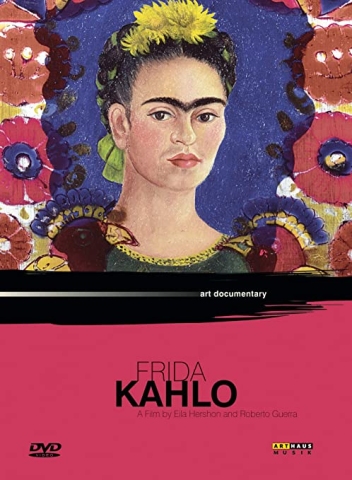
Friday, June 18, 2021 (all day)
Saturday, June 19, 2021 (all day)
Sunday, June 20, 2021 (all day)
Monday, June 21, 2021 (all day)
Tuesday, June 22, 2021 (all day)
Wednesday, June 23, 2021 (all day)
Thursday, June 24, 2021 (all day)
Friday, June 25, 2021 (all day)
Saturday, June 26, 2021 (all day)
Sunday, June 27, 2021 (all day)
Monday, June 28, 2021 (all day)
Virtual Event — Access Info Below
*Traducción en Español a continuación
Frida Kahlo is undoubtedly one of the most extraordinary and radical artists of the 20th century. The narrative begins and ends at her "Blue" house in Coyoacan, Mexico City, where Kahlo spent much of her life. At her death in 1954 her husband, muralist Diego Rivera, presented the house to the Mexican people. The house is now a museum dedicated to her life and work. Rivera is one of the shaping influences on Kahlo. He was a fiery, idealistic, sometimes philandering artist and Communist who Kahlo married, divorced and then married once again.
At the age of 18, Kahlo was involved in a horrendous accident while traveling by bus in Mexico City. She was to suffer the painful effects of the crash throughout her life. She sustained damage to her spine and abdomen and was confined to bed for many months. She began to paint self-portraits and portraits of close family members, as these were the only subjects on hand during her convalescence. Thus Kahlo's painting had a uniquely painful genesis. Kahlo eventually painted over 700 self-portraits in her life, many of them dealing with pain, sexuality and fertility.
Because of the accident, Kahlo was unable to have children and she suffered several miscarriages. The trauma at the root of her art is sensitively explored over the course of the documentary, alongside the idea that these beautiful paintings served in part as a substitute for motherhood. Using her journals, the film goes on to trace the last years of Kahlo's life, finding that as her health deteriorated her attachment to objects, ideals and Rivera become only more intense. The viewer is also introduced to Kahlo as a political figure, and invited to consider the vital place she has come to occupy in Mexico's artistic and political history.
Stream the award-winning 62-minute film at the link above. Log on to Kanopy to watch for free with your library card.
*Una película para iluminar y celebrar la exposición El jardín de Frida Kahlo presentada por la Ópera Steamboat durante el verano de 2021
Frida Kahlo es sin duda una de las artistas más extraordinarias y radicales del siglo XX. La narración comienza y termina en su casa "Azul" en Coyoacán, Ciudad de México, donde Kahlo pasó gran parte de su vida. A su muerte, en 1954, su marido, el muralista Diego Rivera, regaló la casa al pueblo mexicano. La casa es ahora un museo dedicado a su vida y obra. Rivera es una de las influencias determinantes para Kahlo. A los 18 años, Kahlo sufrió un terrible accidente mientras viajaba en autobús por Ciudad de México. Sufrió las dolorosas consecuencias del accidente durante toda su vida. Sufrió daños en la columna vertebral y el abdomen, y estuvo confinada en cama durante muchos meses. Comenzó a pintar autorretratos y retratos de familiares cercanos, ya que eran los únicos temas que tenía a mano durante su convalecencia. Así, la pintura de Kahlo tuvo una génesis singularmente dolorosa. Kahlo llegó a pintar más de 700 autorretratos a lo largo de su vida, muchos de ellos sobre el dolor, la sexualidad y la fertilidad. A lo largo del documental se explora con sensibilidad el trauma que está en la base de su arte, junto con la idea de que estas hermosas pinturas sirvieron en parte como sustituto de la maternidad. A través de sus diarios, la película recorre los últimos años de la vida de Kahlo, descubriendo que, a medida que su salud se deterioraba, su apego a los objetos, a los ideales y a Rivera se hacía más intenso. También se presenta al espectador a Kahlo como figura política, y se le invita a considerar el lugar vital que ha llegado a ocupar en la historia artística y política de México.
Transmite la película de 62 minutos en el enlace de arriba. Entra en Kanopy para verla gratis con tu tarjeta de la biblioteca.
Frida Kahlo's Garden: June 18 — August 11
*Traducción en Español a continuación
Frida Kahlo’s Garden is an exhibition presented by Opera Steamboat.
Admission to the exhibition and associated programs, including the two Library documentaries, is free.
Art exhibition at Steamboat Creates
Monday-Friday: 5-8 p.m.
Saturday & Sunday: 10 a.m.-6 p.m.
The Depot, 1001 13th St. (across from the Library)
Garden installation at Yampa River Botanic Park
Dawn until dusk
1000 Pamela Ln.
This exhibition is made possible by NEH on the Road, a special initiative of the National Endowment for the Humanities. Frida Kahlo’s Garden is adapted from the exhibition, FRIDA KAHLO: ART, GARDEN, LIFE, organized by guest curator Adriana Zavala at The New York Botanical Garden. It was made possible with major funding from the Institute of Museum and Library Services, Karen Katen Foundation, The LuEsther T. Mertz Charitable Trust, MetLife Foundation, National Endowment for the Arts, National Endowment for the Humanities, New York State Council on the Arts with the support of Governor Andrew M. Cuomo and the New York State Legislature, and Gillian and Robert Steel. It was adapted and toured for NEH on the Road by the Mid-America Arts Alliance.
*** Exposición: Jardín de Frida Kahlo
Presentado por: Opera Steamboat
Duración: del 18 de junio al 11 de agosto de 2021
Exposición de arte en Steamboat Creates
Horario: de lunes a viernes de 5 a 8 p. M. Y sábados y domingos de 10 a.M. A 6 p. M.
Ubicación: 1001 13th St, Steamboat Springs, CO 8048
Instalación de jardín en Yampa River Botanic Park
Horario: Desde el amanecer hasta el anochecer
Ubicación: 1000 Pamela Ln, Steamboat Springs, CO 80487
Esta exposición es posible gracias a NEH on the Road, una iniciativa especial del National Endowment for the Humanities. El jardín de Frida Kahlo es una adaptación de la exposición FRIDA KAHLO: ARTE, JARDÍN, VIDA, organizada por la curadora invitada Adriana Zavala en el Jardín Botánico de Nueva York. Fue posible gracias a una importante financiación del Instituto de Servicios de Museos y Bibliotecas, la Fundación Karen Katen, The LuEsther T. Mertz Charitable Trust, MetLife Foundation, National Endowment for the Arts, National Endowment for the Humanities, New York State Council on the Arts, con el apoyo del gobernador Andrew M. Cuomo y la legislatura del estado de Nueva York, y Gillian y Robert Steel. Fue adaptado y realizado para gira para NEH on the Road por la Mid-America Arts Alliance.

